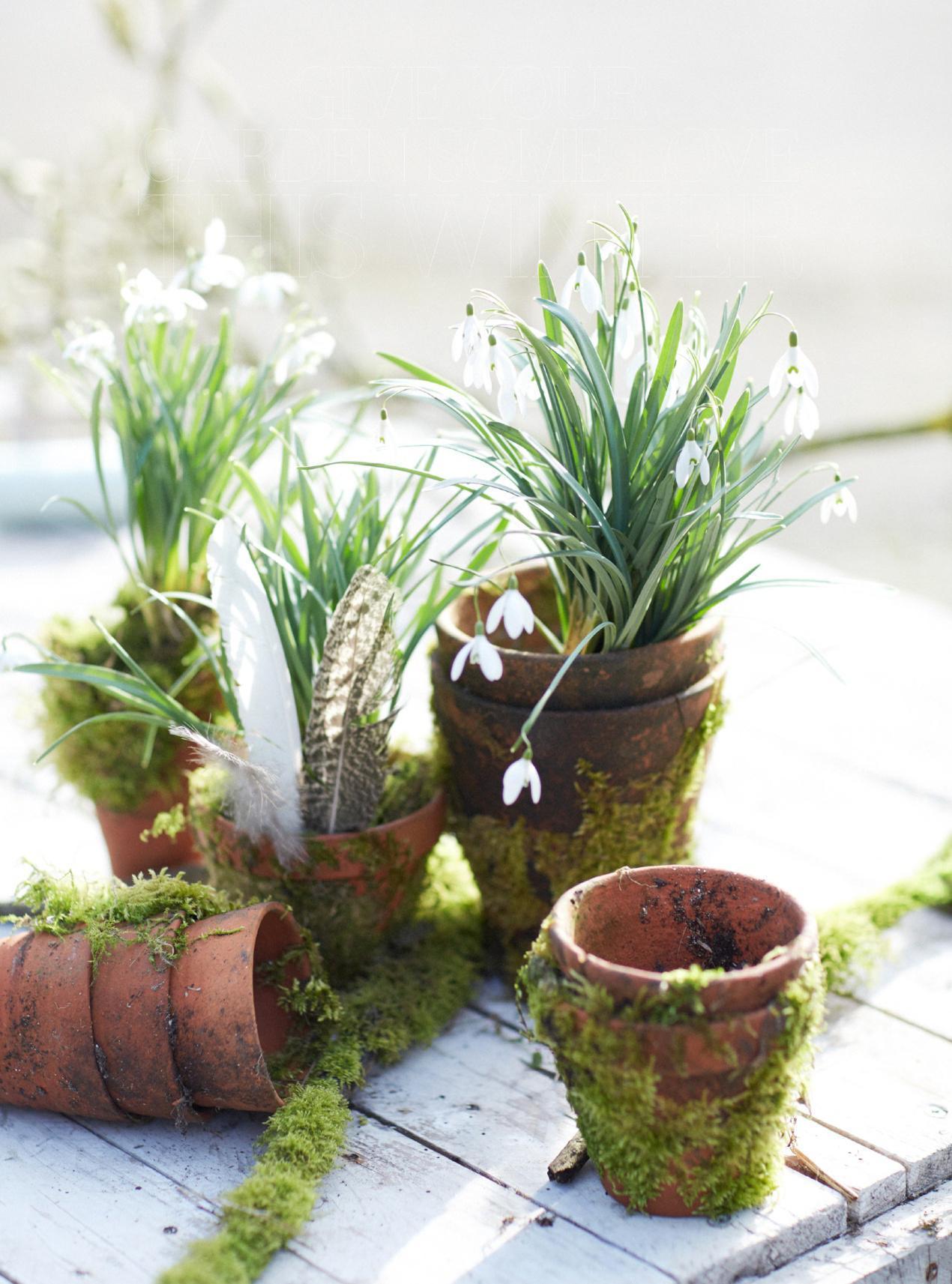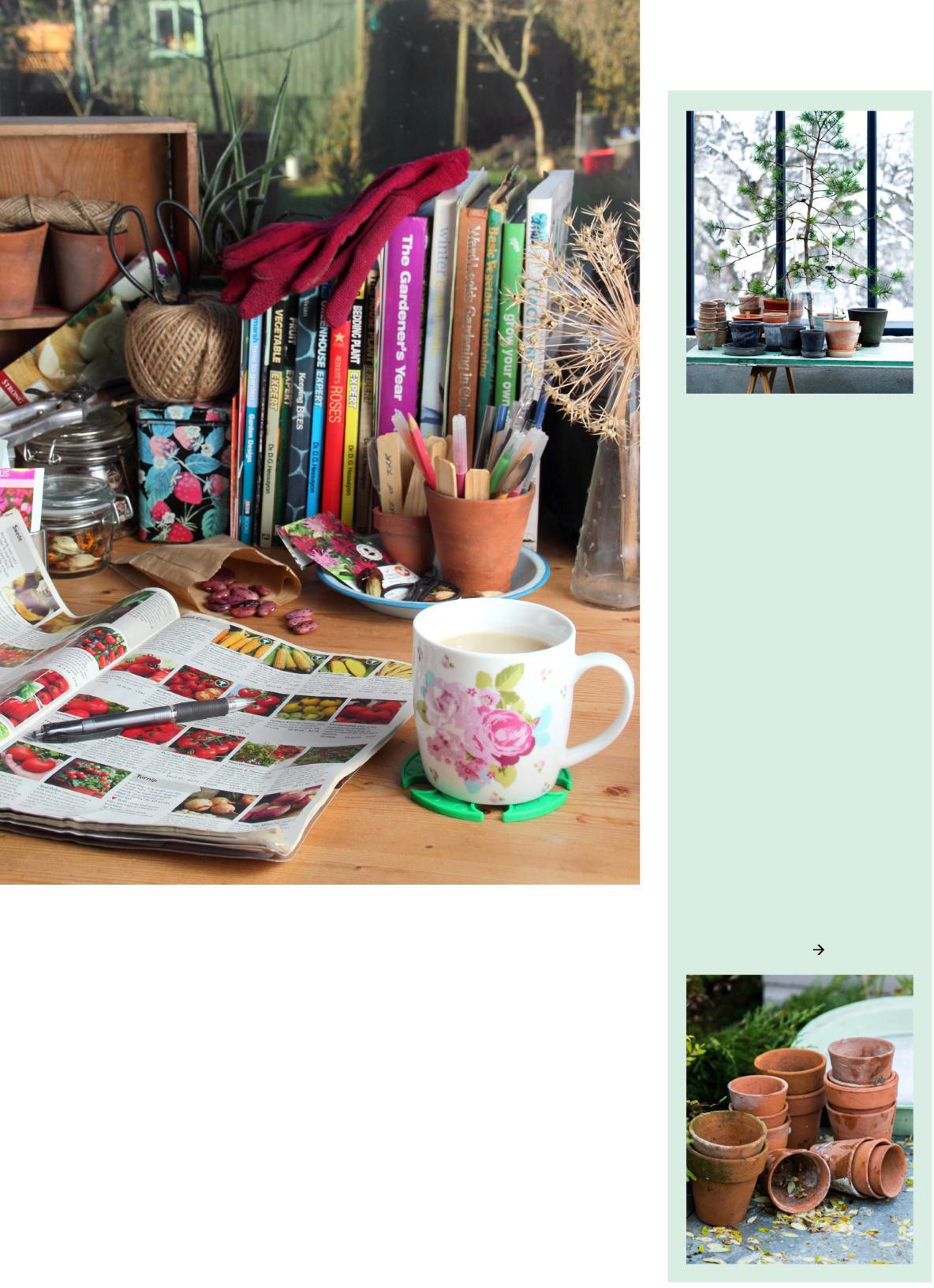
11 minute read
ON THE COVER GIVE YOUR GARDEN SOME LOVE
GIVE YOUR GARDEN SOME LOVE THIS WINTER
You may be counting down the days until spring, but there’s plenty of joy to be found in your outdoor space at this time of year
Advertisement
TURN YOUR GARDEN INTO A WILDLIFE SANCTUARY

However big or small your garden or outdoor space is, you can transform it into a safe haven for birds and insects. When it comes to birds, give them a feeder and they will come. Ideally, leave out food with a high fat content (think grated cheese) as this will help small birds stay warm. Also include grains and nuts for balance. Mix up the foods you leave out as this will encourage difference species. It’ s not just birds though – put out a dish or shallow container of water for other wildlife that needs to drink. You can also make your own insect or bug hotel; just keep it sheltered.
WHAT TO DO NOW (& NEXT)
The start of a new year is the time to take stock and start planning for the months ahead, from what to plant and seeds to sow, to how to care for wildlife. Use our go-to checklist below for the next few weeks…
JANUARY JOBS PREPPING Deadhead winter pansies and clear away any soggy perennial stems. If you ’ ve been collecting seeds over the past year, sort them and decide which ones you want to use. Remove any weeds from your veg plot and dig over the soil. SOWING You ’ll need patience to sow seeds this early, but if you begin now, you ’ll be rewarded later in the year. As well as using new compost, you ’ll also need to clean everything that comes in contact with the seeds. Seed more thinly than at other times of the year, and check seeds and seedlings every day so you ’ re able to act before problems occur. Sow now for a super summer crop of flowers, veg and herbs – we love dahlias, geraniums, petunias, basil and chillies. CARING The coldest month of the year, January is hard work for birds especially. Check any bird boxes and make sure they are secure and haven ’t rotted or been damaged.
FEBRUARY JOBS PREPPING Cut back ivy or other climbers that have become overgrown. If you have an allotment, now is the time to make a start. Your main job this month is to prepare the beds before spring. And get your cloches ready for any early sowings. SOWING You might do most of your planting of summer-flowering bulbs in spring, but you can make a head start on some in February – lilies and agapanthus can both be planted in containers now. CARING Most wildlife will still be hibernating, but hedgehogs might make an early appearance. If some come to visit your garden, leave out water for them as well as meat-based cat or dog food – they
IF YOU ONLY HAVE ONE HOUR TO SPARE…
…sharpen your shears and secateurs and start cutting back. Chop deciduous grasses, such as stipa and miscanthus, to the ground; and ornamental willows and dogwoods to 10-20cm high. Shape late-flowing shrubs and clematis, and if you didn ’t prune lavender in autumn, cut stems just above buds that are about to break, don ’t go too far down into dead wood or it may not come back.
PLANT THESE SEEDS NOW
Green shoots are a few months away yet, but this is the perfect time to get going with seeds, either in the ground or indoors.
Cloches, mini tunnels and cold frames can all really help to get the planting party started at this time of year. The slight protection they offer from the frost makes it possible to sow all sorts of seeds, from peas, beetroots and carrots, to sweetpeas and lettuces. They can be sown directly into the ground, but lettuces and sweetpeas do best planted into individual pots and placed into a cold frame. As the sun gains strength, keep an eye on the temperatures underneath the glass or plastic – it’ll soon be warm enough that you ’ll need to open up the frame or cloche during the day. Sow broad beans directly into the soil. You can do this without any protection at this time of year if you find the sunniest, most sheltered place possible. You can plant a huge variety of seeds indoors if you have some sort of seed propagator. It doesn ’t have to be anything fancy – just a seed tray with a cover that has ventilation, placed in a warm spot. Go for lobelia, cosmos, geraniums, kale and tomatoes. Once the seeds have germinated, move them to the brightest place you can, as they need plenty of sunlight to keep them from getting leggy.

TIME TO NURTURE AND NOURISH
Get ready to feed your plants. They
’ re about to have a huge growth surge and it would really help them get off to a good start. If you have time, dig in well-rotted organic matter but, for a quick fix, sprinkle a balanced fertiliser onto the soil.
BUY NOW, SAVE MONEY
Fill your garden with spring- and summer-flowering plants without spending a fortune. It’ s possible to buy them for very affordable prices if you know where to look.
Shop locally – it’ s a great way to get cheap or even free plants. Look for plants swaps, plant fairs or on local recycling websites. You can often find seeds at the local supermarket or online. Visit dobbies.com for a huge selection at low prices, while moreveg.co.uk supplies seeds in smaller numbers. Consider the discount tables at garden centres, where plants that have been neglected are sold off cheaply. With care they ’ll usually recover. Plants sold in supermarkets and discount shops are often cheap, but may not have been well-cared for, so keep your eye out for newly arrived stock in good condition. For bedding or vegetables, buy small plants, such as plug plants, to save money and time as the really hard work of germination is done for you. With slower-growing shrubs, don ’t buy tiny. A small specimen may not flower for years. Look out for special offers on websites and sign up with online nurseries as they frequently have flash sales and discounts. When buying plants, look out for these signs that tell you they ’ re healthy: lots of leaves and shoots; the top of the compost is weed-free, moist and a dark colour; and there are no yellowing roots poking through the base of the pot.

GET YOUR GARDEN SPRING READY
Put in the prep now, in both your garden and greenhouse, and you ’ll reap the rewards later. Here are some essential cold-weather jobs.
IN THE GARDEN Clean all your tools (including secateurs and hoes). Sprinkle some fertiliser around shrubs and along the base of hedges. Clear away soggy leaves from patios and decking. Scrub any empty pots and seed trays ready for sowing. Sort and clean canes and cloches.
IN THE GREENHOUSE Give the glazing a good wash. Tidy up, removing broken pots and debris that could hide unwanted guests. Improve the shading and heating ready for spring. If there are any sunny days, ventilate the greenhouse to avoid it getting too humid.
PREP YOUR BACKYARD THE SUSTAINABLE WAY
Even though your outdoor space might not actually be green in the middle of winter, you can make sure your approach is. These tips and tricks will keep your garden ecofriendly while you wait for spring.
RECYCLE YOUR CHRISTMAS TREE Turn your fir into woodchip mulch with a shredder (hire one if you don ’t own one). You can also collect the fallen needles and use those as mulch for blueberries. REUSE YOUR PLASTIC POTS As you won ’t be able to recycle them via kerbside recycling, the best solution for pots is to reuse them. Clean them now ready for use later in the spring and summer, or bring them in and use them for houseplants. STORE YOUR RAINWATER Turn the wet days of winter into a positive – install a water butt to collect rainwater now that you can reuse later during dry periods. It’ s perfect for both the garden or greenhouse, and the bonus is the non-purified rainwater is better for overall plant health.

THINK TREES AND HEDGES
Now
’ s a great time to plant trees and hedges. From November to March they can be bought bare root, meaning dug out of the ground and sold without containers. As they haven ’t been looked after in pots, they ’ re cheaper and their roots are likely to be more developed so will establish more easily in your garden.
GETTING TO THE ROOT Some plants are sold as root-balled – these have been dug up in the same way as bare root, but lifted with the soil still around the roots to help them survive the journey to your garden. Root-balled and bare root plants are ordered unseen, which can be nerve-wracking. Take advice from the retailer about the right size and number.
CHOOSING A HEDGE Decide whether you ’d like a deciduous or evergreen variety. If you want screening all year round, go for evergreens like laurel, yew or privet. If you ’d prefer to have seasonal changes or to let more light in during winter, choose deciduous plants such as beech or roses. Also consider how formal you ’d like your hedge to be. Evergreens tend to be neat, almost like green walls, but deciduous plants like roses, lilac and flowering currant are more loose and relaxed. The neater the plant, the more work is involved in keeping it pristine. Finally, think about height and size. Low hedges form an edge rather than a screen: lavender, box and hebes are all good for this. But if you want shading, screening or shelter, you ’ll need taller plants that grow more quickly. For 6ft-tall hedges, choose laurel, privet or beech, and buy them quite big if you can, at least 4ft high, otherwise you ’ll wait for years before they reach the height you want. Whatever size, but especially if you ’ re putting in taller and evergreen plants, it’ s important to keep them watered. Even in winter, evergreens lose water from their leaves so need a good steady supply to their roots.
THE SIZE IS RIGHT If your garden is small, you might not want a tall tree. For a small option, around 6ft, look for dwarf rootstock, where the top of the tree has been grafted on to a trunk with very limited growth. Some are even small enough to survive in planters. For something a little bigger there are varieties of crab apple, cherry trees and mountain ash that are quite small. But watch out for the ‘ eventual size ’ as many can grow 10 metres tall. Also think about what you want the tree for. If it’ s to screen, it needs to be positioned carefully. Trees are difficult to move so it’ s worth imagining a tree in different spots in the garden before planting.
ENTERTAIN IN YOUR GARDEN (EVEN IN WINTER)

OK, yes, it’ s cold and no one wants to freeze. But with the vast array of stylish firepits and chimineas to choose from, a garden party in midwinter isn ’t such an outlandish idea. As long as it’ s dry – or your outdoor space is undercover – all you need is comfy seating and an abundance of throws and cushions, and you have all the essentials to create a spot to spend time with friends and family. Gather around a firepit (Wayfair has a good selection) and the chilly temperatures will barely register. We suggest accompanying a winter garden party with a cider hot toddy: heat 600ml apple cider, 200ml water, 1 sliced lemon, and 150g sugar in a pan. Bring to a simmer over medium heat and cook, stirring until the sugar dissolves. Stir in 400ml whisky, divide among eight glasses and garnish with cinnamon sticks. For more ideas see housebeautiful.com/uk/garden. HB
Buy direct from the publisher and get the best prices and deals on magazine subscriptions, special editions, beauty boxes and much more. We have products for a whole range of hobbies and interests, so treat yourself or a friend today.
Home is where the heart is, and nothing beats sitting down with a cuppa and taking some time out with our inspiring homes and lifestyle titles. Our style guides and fashion titles are perfect for anyone who likes to keep up to date. Plus, spoil yourself with one of our limited-edition beauty boxes.

Discover workout ideas from top personal trainers, plus delicious meals and nutrition tips in our magazines and special editions. You’ll find lots motivation for achieving your health and fitness goals. We have a brilliant selection of magazines for people who love being outdoors, whether that’s nature lovers with their heart in the country, or runners – from beginner to professional and everything in between.
TERMS & CONDITIONS Stock is available at time of going to press. For our data policy, visit hearst.co.uk/privacy-notice



